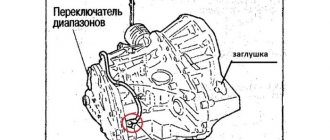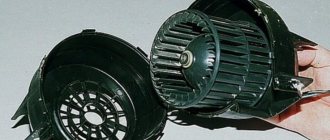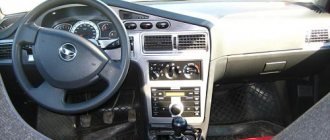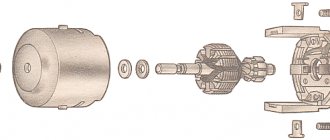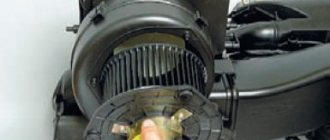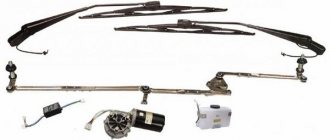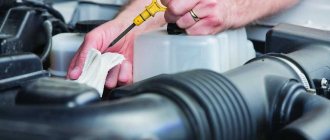Why doesn't the stove work on the VAZ 2114? This is a question many car owners ask themselves. And how to make the VAZ 2114 warm?
Unfortunately, the heating system of the domestic automobile industry still leaves much to be desired. This issue is especially relevant in winter. After all, being cold is not only unpleasant, but harmful, even dangerous to health. And here we are not only talking about the driver’s hypothermia, everything is clear about this. Glasses with a faulty heating system quickly freeze and become covered with frost and ice. Visibility on the road for the driver in such conditions is negligible.
To find out why the stove on a VAZ 2114 does not work, you first need to understand how the stove on a VAZ 2114 works.
Heating in the interior of the VAZ 2114 is arranged according to the classic principle of the line of Samara cars.
Stove fan device
If the VAZ-2115 has stopped heating the interior, first let’s figure out how the stove’s operating system works. The structure is simple: the temperature of the air supplied to the cabin is regulated by the heater tap, when opened, coolant (antifreeze) enters the heater radiator, warming up to 95 degrees. By adjusting the fan operating modes from minimum to maximum, you change the speed of the stove, determining the required amount of incoming heat. All that remains is to direct the air flow in the desired direction using the dampers located along the perimeter of the panel of your car.
Possible reasons
What could have happened? There are several most common options:
- The fuse has failed. In our case it is F7 (30A). The problem is simple and at the same time complex - replacing the fuse is easy, but the reason it blows is that there is a short circuit somewhere in the circuit. In this case, it is better to check the entire safety circuit to avoid recurrence of the problem in the future.
- Ignition relay malfunction. This applies to cases where the fan turns on immediately after the engine has warmed up. There is only one way out - replacing the relay itself, located under the dashboard in the center console.
- Poor contact inside the mounting block. An inevitable problem is a consequence of the operation of the car. The problem can be solved quite simply - just go through the block with wires in the mounting block and, if necessary, replace the oxidized elements.
- The heater switch does not work. To check the serviceability of the switch itself, a regular 12-volt light bulb with two wires is enough. You need to remove the central instrument console, turn on the ignition, connect one wire (“minus”) to body ground, and the second to an additional resistor. If the switch is working properly, the light should light up. Otherwise, connect the lamp to the positive wire on the position switch. If in this case the light does not light, then you need to look for an open circuit or replace the faulty fuse.
- The heater fan motor has failed. If, after checking and eliminating all the possible malfunctions listed above, the heating of your VAZ-2115 still does not start working, there are only a few options left. Poor contact of the fan mass, sticking of the brushes or, in extreme cases, burnout of the motor are possible. In any case, the motor must be replaced, since once it fails, it will continue to regularly cause you inconvenience.
Replacing the VAZ 2115 stove fan
So, a replacement was still needed. There's nothing wrong with that - today you can choose from a variety of alternatives, in a wide range of price ranges. You will have the opportunity to save money, but remember that the main thing when choosing parts for your car is not to go cheap. In general, the average cost of an optimal fan ranges between one and a half thousand rubles.
Removing a faulty fan is not difficult - you only need to have a regular set of tools with you. In the VAZ-2115, the heater unit is located under the hood, directly under the windshield. The procedure is as follows:
- disconnect the terminal (“minus”) from the battery and the power wire (“plus”) directly from the motor itself;
- remove the protective cover of the fan casing, secured with two screws;
- disconnect the ground (the nut located at the bottom connecting to the heater);
- open the casing and unscrew the screws securing the fan and air intake grilles;
- We move the fan towards ourselves a little, removing it from the mount, then turn it 90 degrees and remove it.
The process of installing a new part is carried out in exactly the same way, but in reverse order. After installation, ensure that all fixing screws are properly secured. All that remains is to test the new heating - and you can continue to enjoy the warmth of your car. Good luck on the roads!
HEATING SYSTEM DEVICE
Such a system in these cars consists of several components. This is a fan that blows air over the heater radiator. The device also has air ducts and dampers. This is a separate damper for blowing the windshield, as well as a distribution one - it directs the air flow to the central and side deflectors, as well as to the floor. That's not all. There is also a control valve.
You can also highlight the stove faucet and the resistor that controls the power of the motor. There is also a switch that allows you to change the fan power.
If the heating system is working properly, then the coolant heated from the engine is supplied to the heater radiator through the tap. The temperature of the air, which is pumped into the cabin by a fan, can be controlled - this is what the faucet is designed for. Heat is generated when a fan blows on the heater radiator, which is heated by coolant. When the car engine is heated to operating temperature, the temperature of the antifreeze or antifreeze can reach 95 degrees or more.
The stove on this car can operate in one of three modes. Modes allow you to change the fan speed. Depending on the position of the tap, you can supply both warm and cold air into the cabin.
Principle of operation
Due to the lack of a tap, the heating inside a domestic car is controlled by a hot air power damper. The adjustment is automatic, with an accuracy of two degrees Celsius. The damper has proven to be less practical than the faucet, as the latter can jam, stick or freeze. The main flow of heated or cooled air is evenly distributed throughout the cabin - first onto the windshield, and then passes through the deflectors closed with flaps to the side windows. The floor and footwells are heated using a similar principle. There is also an air recirculation system inside the cabin, which prevents an environmental disaster in the car due to unauthorized entry of outside air polluted and filled with road dust.
FAULTS AND DIAGNOSIS
As you can see, the heater is designed primitively. The operating principle is also very simple. But even so, the stove does not work on most VAZ cars (2115 VAZ is no exception). Let's look at typical faults.
Determining whether the heater has started working or not is very simple. If you turn on the heater in the cabin while the engine is running, the fan should start. If this does not happen, then something has happened and there will be no heat because the stove is not functioning.
In addition, the fan in the stove may not work, cold air enters the cabin, the damper does not work, there are antifreeze leaks, the stove makes various extraneous sounds, and smoke or steam comes out of the air ducts. Sometimes the stove in the VAZ 2115 does not work, it does not blow for no reason.
Introduction
Despite the fact that domestically produced cars are relatively durable, their heating system can fail much earlier. Having wished the “best” to the manufacturer, motorists whose VAZ-2115 heater fan does not work most often discover a problem in the cold season. Driving in a cold, unheated vehicle cannot be pleasant or comfortable; in addition, it is dangerous to health. It is worth noting that we are talking not so much about hypothermia, but about the danger of collision with other road users and structures. Due to the fact that the interior is not heated, the windows freeze very quickly, and a layer of frost and ice appears on them, preventing normal visibility.
FUSE
It’s worth starting to look for the reason from the very beginning. Fuses usually blow. The malfunction is primitive, and you just need to replace the burnt one with a new one. But the fuse failed as a result of a short circuit, and the cause of the short circuit must be found.
This model has two safety blocks. The first can be found under the hood near the left glass, while the second is located in the cabin, under the panel. Two fuse blocks protect the circuits of certain devices.
You can find out which fuse is not working by looking at what is not working yet. For example, if the heater and washer of a VAZ 2115 do not work, then you need to find the fuse that is responsible for the operation of the washers. It is easy to find a burnt element - even an inexperienced driver can easily distinguish a burnt part from a whole one.
Although, due to a non-working heater in these models, there can only be one problem - fuse F7. It is located behind the heater, and the fuse itself is 40 A. It is responsible not only for the operation of the fan, but also for the washer, glove compartment lighting, heated rear window and cigarette lighter.
Minor troubles
And the last trouble that a car owner may encounter is the incorrect supply of air masses to the cabin. Fortunately, adjusting and repairing dampers is a simple procedure! You need to take pliers and bend the cable at the flap under the driver's steering wheel. Then the damper will tightly close the air duct again and the problem is solved.
One of the main advantages of being a car owner is comfort and convenience. This is especially true during cold periods of the year. When there is snow and frost outside, it is much more pleasant to move around the streets in the warmth of your own car. But, unfortunately, equipment tends to fail, and in today’s article we will look at one of such cases so that you are prepared for any surprises.
FIRST AND SECOND POSITION
If the heater only wants to work in the first and second positions, then you will have to be in the car for a long time without heating before it becomes warm. The heater is designed so that in the first and second positions the impulse to the fan comes from the resistor, and in the third position directly.
An additional resistor is needed in the system to ensure the best speed. The resistor has two spirals for two operating modes. When the first stove mode is turned on, the pulse passes through two spirals. If the second mode is turned on, the pulse will follow the second spiral. You can find the resistor near the accelerator pedal. Repairing it is unprofitable. Repairs can only be made if the contacts are burnt. It also makes sense to repair, if the wiring is burnt, it is replaced with a new one.
Remove the contacts from the resistor. Disconnect the fasteners and remove the element. Next, you need to make sure whether the part can be repaired. It is repaired or replaced with a new one.
COLD AIR INTO THE CABIN
This may be due to various malfunctions. What could happen if the VAZ 2115 stove does not work? The reasons are improper replacement of the coolant, depressurization of the cooling system, and a small amount of antifreeze. To remove the plug from the system, you need to remove the heater radiator pipe and add coolant to the maximum. Then start and warm up the engine. The plug will come out on its own under fluid pressure.
Another nuisance is a jammed faucet. This may happen if the valve was not fully opened before, and during operation, scale appeared at its end, interfering with the normal circulation of the coolant. You can unscrew the tap with pliers or replace it.
The fan impeller may be damaged. It should be inspected and, if there is mechanical damage, replaced. If the cabin filter is dirty, then warm air will also not flow into the cabin. The filter needs to be changed.
Problems with the cooling system
When the heater on a VAZ-2114 does not work, reasons other than electrical may lie in the coolant circulation system:
- Air lock . As the coolant cools, air accumulates in the upper part of the radiator. Subsequently, air enters the thermostat and a large circle of coolant movement is blocked. The heater core remains cold. There are many ways to fix the problem. But the easiest thing is to squeeze out excess air from the system. To do this, unscrew the cap from the tank. With the engine running, the cold hose is intensely compressed, causing air to escape into the reservoir. If this method does not work, you will have to disconnect the hose to remove the air lock.
- Radiator . Few people devote time to maintaining their car, and especially the heating system. The internal space becomes clogged with dirt, which impedes the flow of coolant. The outer multi-cellular surface becomes clogged with dust and foreign objects, which interferes with heat transfer. In this case, only cleaning the radiator and replacing the cabin filter will help.
- Water pump . Wear of intake blades leads to a decrease in productivity and, consequently, a drop in pressure. Reduced idle pressure is unable to supply heated coolant to the radiator. Only high engine speeds allow you to create the necessary pressure.
- Low coolant level. An antifreeze level below the minimum provokes airing of pipelines. You just need to add antifreeze to the maximum level.
- Cylinder head gasket . A gradual decrease in coolant level, intense white smoke from the exhaust system and the smell of gasoline (oil) in the tank indicate a burnt-out gasket. Through the gap that appears, antifreeze enters the cylinders and into the crankcase with oil. Replacing the gasket requires removing a large number of parts.
- Thermostat . The operating principle of the thermostat is based on the property of a certain metal to change its original shape when the temperature rises. If the element fails, the coolant moves in a small circle without entering the heater radiator. In this case, only replacing the thermostat will help.
- Faucet. It regulates the flow of coolant, that is, the temperature inside the car. If it breaks, the fluid flow stops. Although it is held on by two screws, it is installed in a hard-to-reach place, under the dashboard, which is associated with certain difficulties.
- Hoses . Connecting rubber hoses become unusable after prolonged use. They crack and break. Through the formed cracks, the system depressurizes, and consequently, antifreeze leaks, air gets inside, etc.
vote
Article rating
